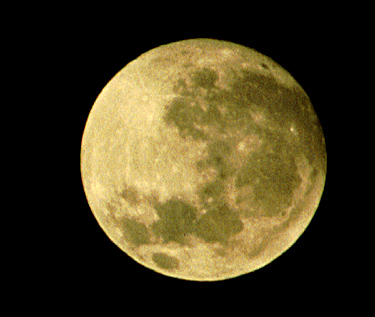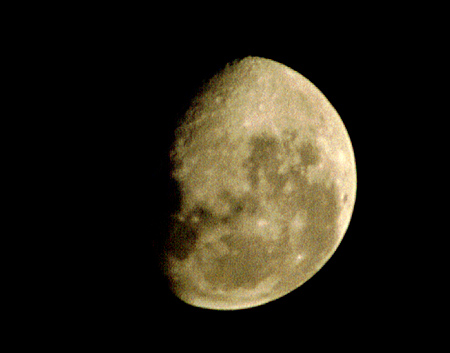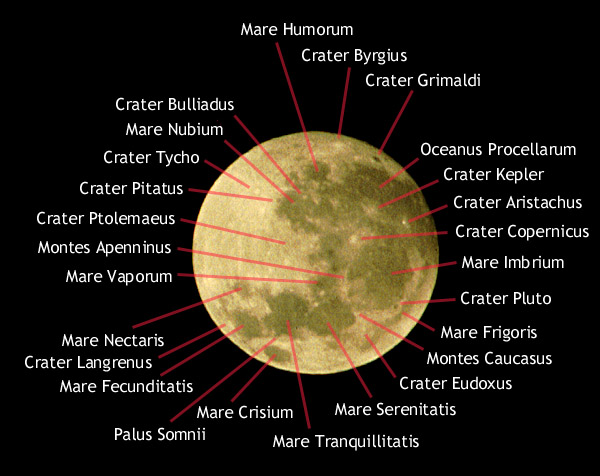Astrophotography - My Beginning
The following images represent my first approach to astrophotography.
The results are not satisfying but acceptable for the simple setup I used.

Location: Hannover/Germany - 9°46'e 52°22'n
Date: 29.12.2001 - ~20:00
I used my Sigma 600mm mirror lens on my Manfrotto 055 tripod, pictures
were taken with my Canon T90 on Fuji Sensia 100. I scanned the slides
on my Olympus ES-10 and performed image processing with Photoshop.
Finding a correct exposure is quite easy: The moon is an object illuminated
by the sun so the good old "sunny 16" rule can be applied when the sky
is clear. f16 at ISO100 with 1/100s exposure time should give a correct
exposure. The fixed f8 of my lens (effictive aperature should be around
f10) gives a shutter speed of about 1/250s. The results proof that assumption
for fullmoon when skies are clear. I would even underexpose the fullmoon
next time one step(1/500s) to get better scanable slides and to minimize
tripod shake effects.

Location: Paderborn/Germany - 8°45'e 51°42'n
Date: 03.01.2002 - ~7:00
Problems
Even the sharpest of the resulting slides are not satisfying for many
reasons:
- Seeing
Without knowing any better I took the images from an open window.
Warm air emerging from the room into the winter night caused an blurred
and wobbling vision resulting in unsharp images with lack of contrast
and distortions.
The overall seeing might have been suboptimal as well.
- Focussing
Accurate focussing on the matte std focussing screen of the T90 is
quite a guess. Split image and microprism ring doesn't help much either.
The focussing screen is too course grained to resolve the fine structures
of the moon surface which isn't too contrasty.
- Camera/tripod shake
600mm focal length is a challenge for a photo tripod. The Manfrotto
055 is quite sturdy but at 600mm extreme caution is necessary in order
to get sharp images. It's a good idea to use a cable release or the
self timer of the camera. In most cases mirror pre-lock is more a
hype but for this application it's worth a try. I will use my Canon
EF with mirror pre-lock next time.
- Resolution of
- Film
Even with 600mm focal length, the full moon covers only a smaller
area on the slide/negative. The diameter of the moon on the film
calculates like:

I can measure exactly that value on the slides. With that diameter,
the moon disk covers only 23,76 square mm on the slide - only
about 2,75% of the complete frame of 35mm film. On this small
area, even the fine grain of modern ISO100 slide films affects
image quality.
- Scanner
The resolution & scan quality of the Olympus ES-10 is not sufficient
to project all details of the slides especially on that small
film area of interest.
- Dynamic range of scanner
The Olympus ES-10 has been a film scanner targeting the home user.
It should be out of production for some time. The dynamic range and
color resolution it's able to capture is quite limited. As a consequence,
fine shaded areas in the slide result in flat colored squats in the
scan without texture.
Digital image processing
- Scanning
Images have been scanned at max. scanner resolution of 1770 dpi.
- Channel alignment
The green channel of the scanner has a noticable shift of 4-6 pixels
compared to the red and blue channels at max. resolution.
- Level adjustment
To get better contrast an adjustment of the brightness levels (range
compression) has been made.
- Resize & cropping
The images have been cropped to the areas of interest and resampled
to 25% of the scan resolution.
- Unsharp mask
To enhance structures on the moon surface, heavy filtering using "unsharp
mask" has been performed. As a result the very flat detail contrast
is enhanced but also the edge of the moon to background gets an unnatural
"burned out" effect and the moon surface gets quite grainy.

Legend to some visible objects on the moon surface
Last change of this page: 12.02.2002

|



